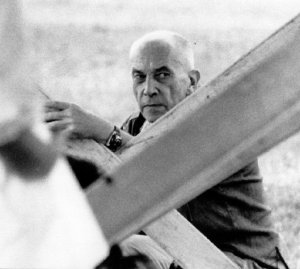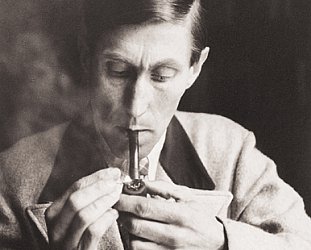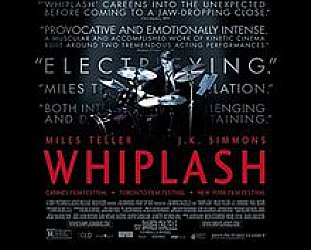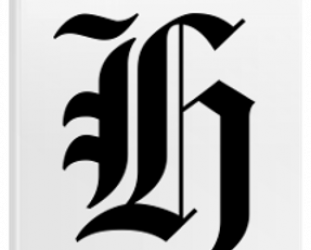Graham Reid | | 3 min read

Few poems of the 20th century have as much emotional resonance and visceral power as T.S. Eliot’s The Hollow Men. Published in 1925 when the trench horrors of World War I had been fully revealed, the poem conjured up a philosophical ennui as Old Europe was trying rebuild out of ashes and despair.
Book-ended by much-quoted lines -- it opens “We are the hollow men, we are the stuffed men” and closes with “this is the way the world ends, not with a bang but a whimper”-- the poem alludes to futility, the soul in limbo, the eyes of the dead watching the living, and is replete with striking images: “cactus land“; “crossed staves in a field“; “the supplication of a dead man’s hand“; “this valley of dying stars” . . .
The poem -- much analysed but always moving -- was the inspiration behind a compelling 2004 video installation by the French filmmaker Chris Marker (born Christian Francois Bouche-Velleneuve) who used some of Eliot’s lines projected on eight, integrated horizontal screens and inter-cut them with striking photographic images and words drawn from relevant sources such as Eliot‘s equally powerful poem The Wasteland.
The exhibit, commissioned for the re-opening of New York’s Museum of Modern Art, was accompanied by a muscular solo piano soundtrack (written by the late Toru Takemitsu and played by the Australian Roger Woodward) which is oceanic in its thunderous washes of atonality.
Entitled Owls at Noon Prelude: The Hollow Men, the installation is gripping in its imagery: faded photographs of the war which inspired Eliot; pictures of the fallen lying in muddy tranches who look nothing like “the Glorious Dead” which has passed into the language as a way of avoiding the horrific reality; frozen eyes wide in fear or betraying a dead soul within . . .
The 20 minute piece is absorbing if uneasy to watch, but has a subtlety crafted narrative of its own. It is also as much about the medium of photography and digital video as it is about dark thematic undercurrents.
 The late Marker - born in Paris or Mongolia in 1921, no one is quite sure - was long recognised as an innovative filmmaker who established his reputation in the 50s alongside French New Wave directors such as Alain Resnais (with whom he directed Les statues meurent aussi in '53), Francois Truffaut and Jean-Luc Goddard.
The late Marker - born in Paris or Mongolia in 1921, no one is quite sure - was long recognised as an innovative filmmaker who established his reputation in the 50s alongside French New Wave directors such as Alain Resnais (with whom he directed Les statues meurent aussi in '53), Francois Truffaut and Jean-Luc Goddard.
Yet as with Resnais, Marker was never firmly in the New Wave camp and he had begun his career as a writer. A hallmark of his films was a quasi-documentary imperative, the use of strong and sometimes still images, and a sense of post-war disillusionment evident his most well-known works, La Jetee (1962) and Sans Soleil (1982), both of which involve a character in search of memory through blasted emotional landscapes.
“When I first saw Sans Soleil,” wrote the New York artist and critic Jason Simon in Art Forum in 2007, “I felt I was watching a newsreel of consciousness.”
For a man who remained scrupulously out of the spotlight -- he rarely gave interviews, details of his early life are sketchy, he made more than 50 films which he seemed to be in no hurry to have archived or curated -- Chris Marker was highly influential.
He pioneered a signature style of documentary essay and his sci-fi/time travel film La Jetee -- composed almost entirely of stills -- inspired Terry Gilliam’s '95 feature Twelve Monkeys which starred Bruce Willis as the time traveller.
An eerie monochrome narrative at only 30 minutes, La Jetee was usually shown as a short in cinemas during the 60s and became a cult item among film aficionados. Cultural drift-netter David Bowie referenced it in the video for his '93 single Jump They Say about his schizophrenic brother who had committed suicide.
But if Marker was on the margins of popular culture and cinema, there is no denying the emotional authority of La Jetee and Owls at Noon Prelude. Both speak to dark recesses of the soul and intellect, yet put on screen memorable images which are allusive rather than overt.
Photographs in Owls at Noon Prelude sometimes dissolve into fragmented pixels or come so close as to break down into abstract images where they have a textural quality. Words deconstruct into letters which move across the screens between related images of eyeless faces or hands taut with fear.
 And in La Jetee the cutting between unflattering close-ups and discomforting half-lit underground chambers creates such a sense of narrative you can forget the film is composed of stills. The brief sequence using moving footage comes as a surprisingly romantic moment in a narrative largely devoid of such a sentiment.
And in La Jetee the cutting between unflattering close-ups and discomforting half-lit underground chambers creates such a sense of narrative you can forget the film is composed of stills. The brief sequence using moving footage comes as a surprisingly romantic moment in a narrative largely devoid of such a sentiment.
Chris Marker was a dark filmmaker but these two important works can be mesmerising. Both raise questions about collective memory, war, consciousness and the intensity of images.
They are by a rare - and rarely seen - filmmaker whose work is located somewhere between the gallery and the cinema, an installation and a movie, and photography and film.
Chris Marker died in Paris in July 2012. He had turned 91 the day before.







post a comment